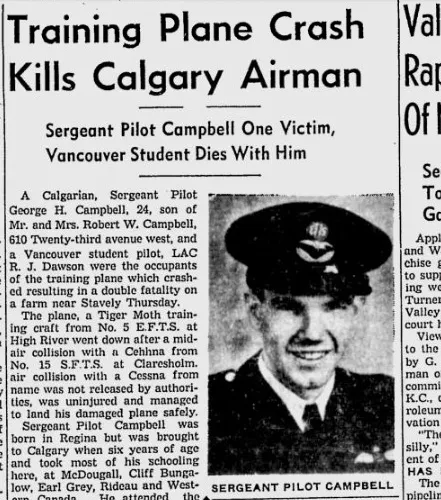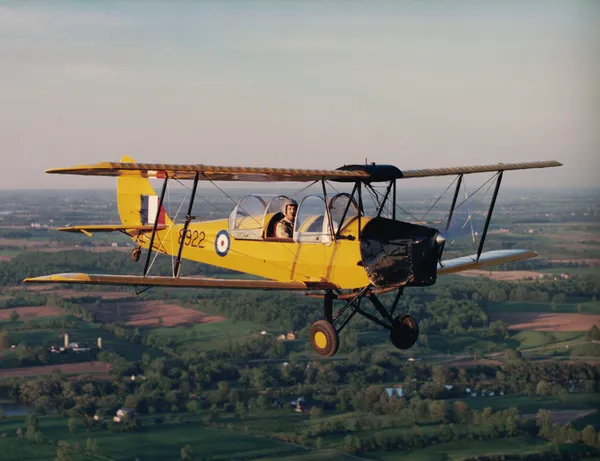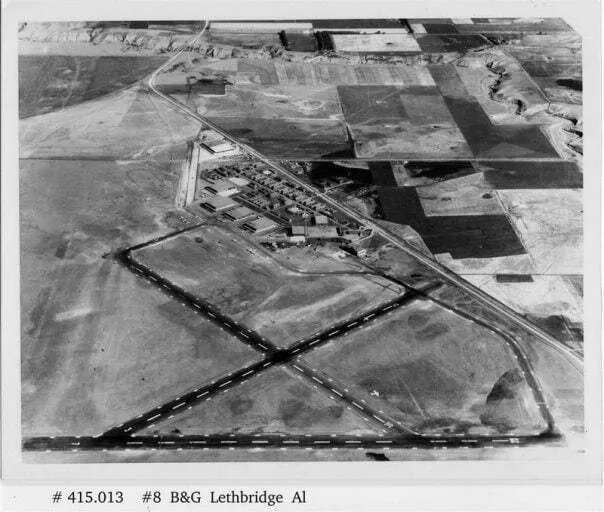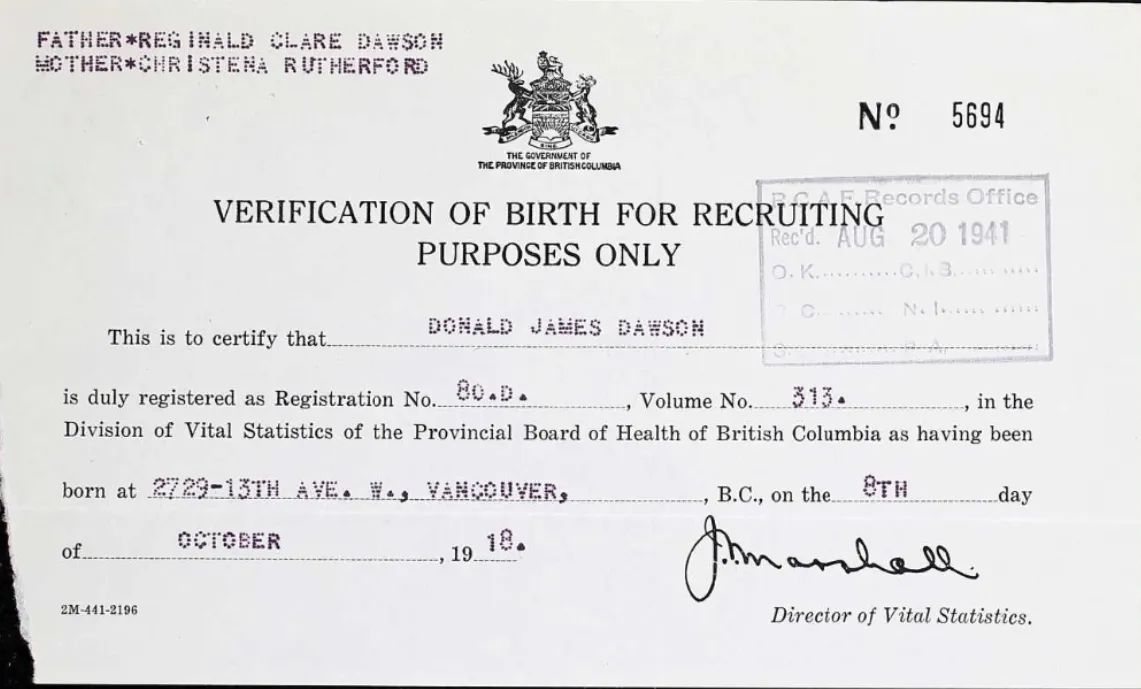Sergeant Campbell was killed when Tiger Moth aircraft 4995 was in a mid-air collision. The aircraft crashed and burned one half mile south of Stavely, Alberta. Leading Aircraftman D.J. Dawson was also killed.
Campbell, George Hollands (Sergeant)
Killed in Flying Accident 1942-February-12


Birth Date: 1917-July-14
Born: Regina, Saskatchewan
Parents: Robert Mamoch Campbell & Isabelle Stevenson Hollands
Spouse:
Home: Calgary, Alberta
Enlistment: Calgary, Alberta
Enlistment Date: 1941-January-24
Service
RCAF
Unit
5 EFTS- Elementary Flying Training School
Base
High River, Alberta, Canada
Rank
Sergeant
Position
Pilot
Service Numbers
R/77936
This incident involved multiple aircraft:
- Moth, Tiger I Serial: 4995
- Crane Mk. I Serial: 8661
All the above aircraft in the above list are referenced in this report.
Crew or Other Personnel
Moth, Tiger 4995
Accident Card - de Havilland Moth, Tiger I serial:4995
This accident involved 2 aircraft on 1942-February-12. They are: Cessna Crane s/n 8661, Tiger Moth s/n 4995.
This accident involved 3 people. Anderson AE, Campbell GC, Dawson DJ
This accident had 2 fatalities. Leading Aircraftman Donald James Dawson RCAF Killed in Flying Accident service no:R/122260 Moth, Tiger 4995, Sergeant George Hollands Campbell RCAF Killed in Flying Accident service no:R/77936 Moth, Tiger 4995
Moth, Tiger serial: 4995

The de Havilland DH.82 Tiger Moth is a 1930s British biplane designed by Geoffrey de Havilland and built by the de Havilland Aircraft Company. It was operated by the Royal Air Force (RAF) and many other operators as a primary trainer aircraft. In addition to the type's principal use for ab-initio training, the Second World War saw RAF Tiger Moths operating in other capacities, including maritime surveillance and defensive anti-invasion preparations; some aircraft were even outfitted to function as armed light bombers.
The Tiger Moth remained in service with the RAF until it was succeeded and replaced by the de Havilland Chipmunk during the early 1950s. Many of the military surplus aircraft subsequently entered into civil operation. Many nations have used the Tiger Moth in both military and civil applications, and it remains in widespread use as a recreational aircraft in several countries. It is still occasionally used as a primary training aircraft, particularly for those pilots wanting to gain experience before moving on to other tailwheel aircraft.
Overseas manufacturing of the type commenced in 1937, the first such overseas builder being de Havilland Canada at its facility in Downsview, Ontario. In addition to an initial batch of 25 Tiger Moths that were built for the Royal Canadian Air Force (RCAF), the Canadian firm began building fuselages which were exported to the UK for completion. Canadian-built Tiger Moths featured modifications to better suit the local climate, along with a reinforced tail wheel, hand-operated brakes (built by Bendix Corporation), shorter undercarriage radius rods and the legs of the main landing gear legs being raked forwards as a safeguard against tipping forwards during braking. In addition the cockpit had a large sliding canopy fitted along with exhaust-based heating; various alternative undercarriage arrangements were also offered. By the end of Canadian production, de Havilland Canada had manufactured a total of 1,548 of all versions. Wikipedia
Aircraft Images
Moth, Tiger 4995
Moth, Tiger I 4995
Category A damage on 12 February 1942 while with No. 5 Elementary Flying Training School at High River, Alberta. Burnt.1941-05-21 Taken on Strength 2019-08-20
1942-February-12 Accident: 15 Service Flying Training School Loc: Stavely Alberta Names: Anderson | Campbell | Dawson
1942-08-18 Struck off Strength Struck off after mid air collision. 2019-08-20
Crane 8661
Crane Mk. I 8661
First assigned to No. 15 Service Flying Training School at Claresholm, Alberta. Still with this School when it received Category B damage at 11:30 on 12 February 1942, 1/2 mile south of Stavely, Alberta (7 miles north of the Claresholm aerodrome). This aircraft collided in mid-air with Tiger Moth 4995 from No. 5 Elementary Flying Training School at nearby High River, and made a forced landing. To Prairie Airways for crash repairs, 18 February 1942, with 116:00 logged time. To No. 2 Training Command on 10 July 1942. Pending disposal from 27 April 1944. To No. 2 Air Command on 1 December 1944, still pending disposal. Stored at No. 201 Holding Unit at Estevan, Saskatchewan, where it was noted with 2102:35 total time, 10:00 since overhaul.1941-12-23 Taken on Strength No. 4 Training Command 2019-08-20
1942-February-12 Accident: 5 Elementary Flying Training School Loc: Stavely Alberta Names: Anderson | Campbell | Dawson
1943-September-10 Accident: 4 Service Flying Training School Loc: R2 Osler Names: Claridge | Ruttle
1945-02-20 Struck off Strength Struck off, to War Assets Corporation for disposal 2019-08-20
Unit Desciption
5 EFTS (5 Elementary Flying Training School)
An Elementary Flying Training School (EFTS) gave a trainee 50 hours of basic flying instruction on a simple trainer like the De Havilland Tiger Moth, Fleet Finch, or Fairchild Cornell over 8 weeks.Elementary schools were operated by civilian flying clubs under contract to the RCAF and most of the instructors were civilians. For example, No. 12 EFTS Goderich was run by the Kitchener-Waterloo Flying Club and the County of Huron Flying Club.The next step for a pilot was the Service Flying Training School.
Established in 1940 at the present site of Lethbridge Airport CYQL.
More information on the RCAF Station at Lethbridge AB can be found at RCAF.Info - RCAF Station Lethbridge AB
NO5 EFTS moved to High River AB 28 June 1941
RCAF.info - RCAF Station High River AB
RCAF.Info - Relief Landing Field Frank Lake AB
![]() Bomber Command Museum Of Canada
Bomber Command Museum Of Canada
